What Sofa Fabric Types To Choose? Natural vs. Synthetic

The sofa is one of the most important furniture pieces in a home. In a living room setting, the sofa is also the most noticeable feature of the space. With all the constant use and the everyday wear and tear that the sofa is subjected to, it is just fitting for it to be made with materials that are extremely durable, reliable, and strong. The fabric, being a main component of a sofa’s construction, must not only be aesthetically pleasing but it has to perform well even when exposed to dirt, dus,t and friction. With the right sofa fabric, you can not only alter the entire look of a room but also maximize the potential and lifespan of your furniture.
Below we give you our ultimate guide on sofa fabric types along with some of their advantages and disadvantages to help you decide which one is the best for your home. To see popular sofa styles visit this gallery.
Natural vs Synthetic Fabrics
Fabrics, in general, are typically categorized into two major types — natural and synthetic fabrics. Natural fabrics, as its name suggests, are made up of fibers derived from natural resources such as plants and animals. Common examples of natural fabrics are cotton, linen, and leather. Synthetic fibers, on the other hand, are entirely man-made and produced from chemical based materials. Some popular synthetic fabrics are polyester, acrylic and rayon.
Natural Fabrics
Cotton: One of the most popular types of fabric not only for upholstery and interior soft furnishings is cotton. Cotton is all-natural as it is derived from the cotton plant. It is considered to be one of the most comfortable fabrics available in the market because it is very breathable.
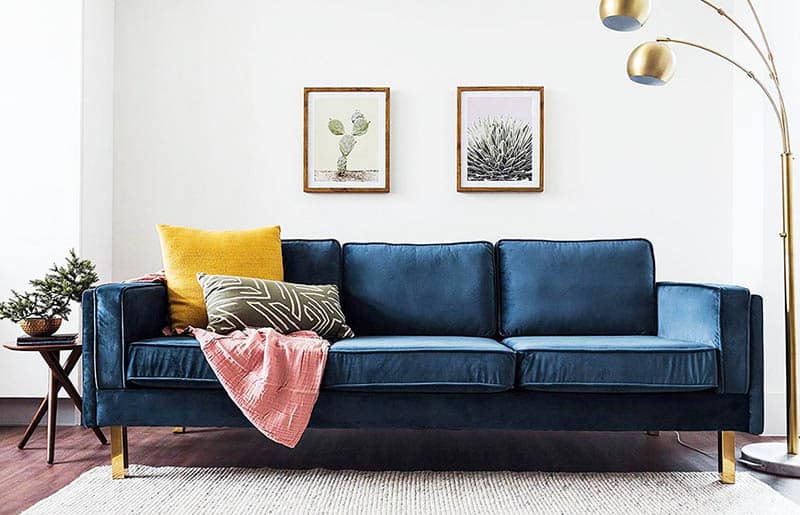
Cotton fabric is available in different styles, colors, and designs. It can be silky or rough, thick or sheer, smooth or textured. It is a very versatile sofa fabric and can work with a lot of sofa styles and designs. What makes it a good option for a sofa: Cotton is best loved for its soft texture. It is resistant to fire, soiling wearing, fading, and piling. This natural fabric also does not wrinkle easily and is not hard to care for. Cotton is also very hypoallergenic, which makes it the most suitable sofa fabric for people with sensitive skin.
The drawbacks of cotton fabric: Cotton is prone to shrinking and has little resilience compared to other materials. Since this type of sofa fabric is soft, it also wrinkles more easily. It is also absorbent, which makes it prone to staining as spilled liquids can easily seep into it, however, maintenance is fairly easy.
Cotton Blend: The durability of cotton fabric depends on its weave and finish. To improve the weakness, quality, and resistance of cotton, it is sometimes combined with other fibers. These more sturdy counterparts of cotton are called cotton blends. In some cases, cotton fabrics are also subjected to surface treatments to make them more stain-resistant and suitable for everyday use.
The strong qualities of cotton blends are very similar to cotton fabrics but are far more improved. These types of fabrics are very family-friendly options for couches or sectional sofas. Examples of popular cotton blend fabrics available in the market are textured cotton, cotton twill and cotton polyester.
● Textured Cotton: Textured cotton fabrics are more rough compared to regular cotton fabric. Textured cotton has a very nice look to it but is not suitable for heavy use. This type of sofa fabric is ideal for rooms that do not get a lot of traffic at home, like the den or home office.
The drawbacks of textured cotton fabric: Textured cotton fabric wears more easily, so once the surface of your sofa begins to become overused, it looks old more quickly as compared to other fabrics. Since this type of fabric is textured, dirt and other particles can be trapped more easily in its grooves, leading to staining and odors.
● Cotton + Polyester blend: Polyester is a type of synthetic fiber that is best known for its durability. Aside from being used in clothing, this type of fabric is also used for many interior applications and soft furnishings. Combining it with cotton reinforces the strength and resistance of the fabric making it one of the most economical and practical choices for sofa fabrics in the market today.
What makes it a good option for a sofa: The polyester element in cotton blend fabrics adds durability and improves the overall quality of the material. Cotton polyester sofa fabric is resistant to most chemicals and mildew. It does not shrink, stretch or wrinkle easily and can hold up better from the wear and tear of everyday use.
This sofa fabric is also extremely strong and retains its shape making it an excellent choice for high traffic areas in the home like the living room or family room. It is also hydrophobic in nature, which means it gets dried more easily once in contact with liquids. In addition to its remarkable properties, cotton + polyester fabrics also come in a wide array of colors and design which adds to the look of the sofa.
● Cotton Twill – Twill actually refers to how a fabric is woven. Cotton twill is a type of fabric that is mainly composed cotton fibers woven in a twill pattern or in diagonal parallel ribs. This type of sofa fabric is ideal for use in high traffic areas and is also highly suited for households with pets and children.
Cotton twill is available in a wide variety of designs and colors. The multicolored variants are the best choices since they show soiling less as compared to the solid colored ones.
What makes it a good option for a sofa: Cotton twill performs better when it comes to wearing, tearing, water resistance and wrinkling. In terms of durability, twill surpasses plain weave fabrics because its diagonal weave reinforces its strength. Cotton twill is also a cost efficient choice as it can last for years.
Linen: Linen is another type of natural fabric that is made from the fibers of the flax plant. This collective term also sometimes refers to a class of textiles that are knitted or woven. It has a loose weave but its surface does not have bumps and is not nubby.
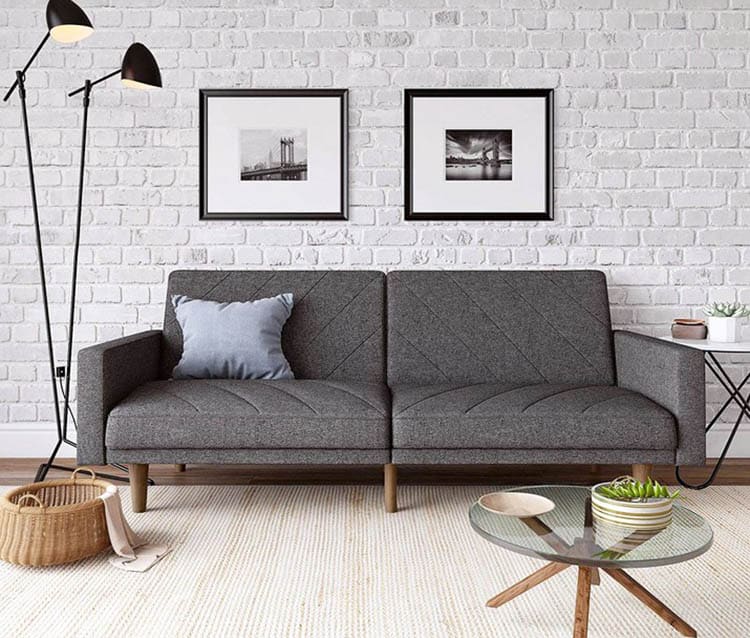
Linen fabric undergoes a tedious manufacturing process, which makes it a stronger fiber than cotton. However, this type of fabric is best suited for rooms that do not receive high traffic such as formal living rooms and home offices. Linen also drapes more elegantly because of their loose weave, making it a great option for sofa slipcovers. But it also means the threads are more susceptible to wear out because they aren’t as tightly woven together.
What makes it a good option for a sofa: Although linen is not at par with other sofa fabrics in terms of durability, it still has the ability to resist piling. It also does not fade easily. Compared to cotton fabric, linen is more absorbent and dries faster. Linen fabric is also best loved for its coolness, making it a highly suitable option for areas that have hot and humid weather.
The drawbacks of linen fabric: Since the threads and fibers of linen fabric is not as tightly woven together, it can become a potential problem in terms of use. They are generally more susceptible to wearing out. Linen requires more effort to maintain since it soils and wrinkles easily. When soiled, linen has to be professionally cleaned to avoid shrinkage. As mentioned earlier, this type of sofa fabric is not advisable for use in high-traffic areas because it can not withstand heavy wear and tear.
Leather: Leather is another type of natural fabric but it is animal based. It is created by drying and tanning animal skins and rawhide. There are several sources of leather such as goat, buffalo and exotic animals like alligator and ostrich. The most common material used for making leather is rawhide.
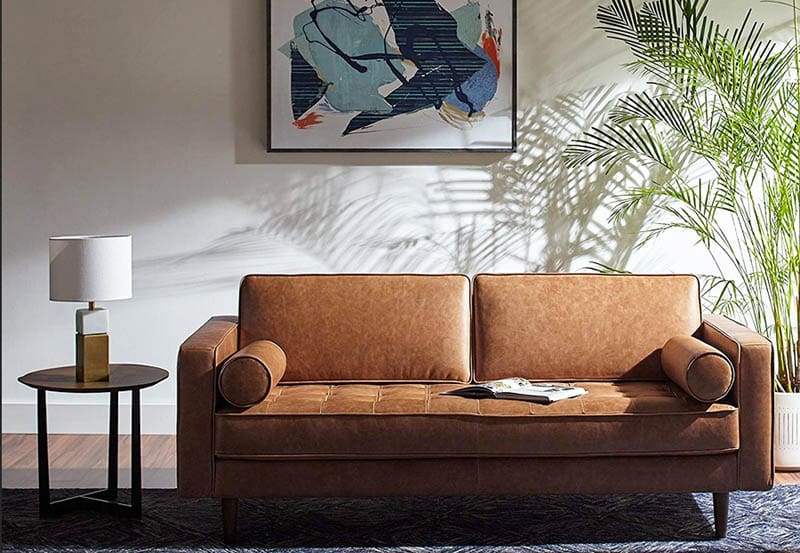
Leather is considered to be the most expensive type of fabric for sofa upholstery. It is prized for its high quality, luxurious fee,l and remarkable durability. Leather can also be used as a sofa fabric in different design styles. It works for both traditional and modern homes. When used for sofa upholstery, leather can bring in a distinct rich feel and refined vibe to a space.
What makes it a good option for a sofa: The most enduring characteristic of leather is that it ages gracefully. The more you use it, the softer and more comfortable it becomes. Although it shows signs of wearing, this adds to the leather sofa’s appeal and aesthetic. Leather is also very durable and flexible. It can withstand wear and tear of heavy use which makes it a very suitable material for homes with small children and pets. It does not get easily damaged when scratched by pets with sharp claws.
Another remarkable characteristic of leather is easy maintenance. Although tough, leather sofas can be cleaned easily by gently vacuuming and wiping with a damp cloth. If needed, it can also be cleaned with saddle soap and leather conditioner. Unlike other fabrics, leather does not smell foul.
The drawbacks of leather: There are minimal advantages to using leather as a covering for a sofa and one of them is that it can feel sticky in hot weather. So if you are living in a country which is very humid, you might want to rethink your options. While leather is highly durable and very forgiving when it comes to scratches, it can still be cut by sharp objects like keys, razors and knives. And once cut, it is impossible to restore it back to its original state.
Bonded Leather Blend: Bonded leather is a blend of materials that is considerably cheaper than an all leather sofa. The bonded leather shredding process uses scraps of leather combined with other materials to create this product. for this reason it is considerably less durable. They are also more likely to fade under direct sunlight. The material blend varies depending on the manufacturer however most bonded leather sofas are made up of a majority of polyester followed by a mix of cotton and leather.
Wool: Just like leather, wool is another natural textile fiber derived from animals, specifically sheep, goats, bison, rabbits and llamas — the most common source being sheep. Wool is made by shearing it from the sheep and spinning it into long strands. These strands are them woven to create a fabric which can be used in a variety of applications like clothing and interior furnishings.

Wool is very elastic, that’s why it works well as a sofa cover. Although very durable, wool is sometimes combined with other fibers to reinforce its strength — these type of fabric is known as wool blends. Wool blended when blended with synthetic fibers is more tolerant when it comes to felting (felting is when the fibers bond together until they resemble felt).
What makes it a good option for a sofa: Wool is best known for its high durability and sturdiness. It offers good resistance to soiling, fading, piling and wrinkling. Wool blends are easy to clean and maintain. It holds moisture well but does not feel wet and works well as a sofa cover for homes in cold locations as it is a great thermal insulator.
The drawbacks of wool: One of the disadvantages of wool sofa covers is that it can feel “scratchy” despite being smooth. Heat and moisture can also cause it to feel.
Silk: Silk is a byproduct of silkworms — the larvae or caterpillars of the domestic silkmoth. When the fibers are harvested from the silkworms, it is then heated with steam and spun into long threads. These threads are then treated and woven together to make silk fabric. Dyes are also applied to the threads to give them different colors.
What makes it a good option for a sofa: The best thing about silk sofa covers is their texture and feel. Silk is very smooth and cool to the touch. It also has a very distinct luster which can add an interesting visual component to a home. In addition, it can bring a very rich and luxurious vibe to a space. Despite being lightweight, silk is strong and is stain resistant.
The drawbacks of silk: Silk is very delicate, which makes it only suitable for sofas in low-traffic areas. It is not a good option for homes with kids and pets, but you can definitely use it in formal living rooms — where it won’t be prone to much soiling and stains. Maintenance can also be challenging because when it is soiled, it requires deep cleaning.
Silk is a very expensive material, so if you are eyeing it for your sofa cover, make sure to prepare a ot of budget for your required yardage. It can also be hard to preserve as it degrades over time.
Synthetic Fabrics
Velvet – Velvet can actually be made of synthetic or natural fibers. It is a type of woven fabric that has evenly distributed, tufted cut threads. Velvet has a tighter weave compared to other fabrics because it is not just woven horizontally, but it also has a pile or nap. The threads rather than being flat, stand upright and the short dense pile gives it a very distinct soft feel and fuzzy texture.
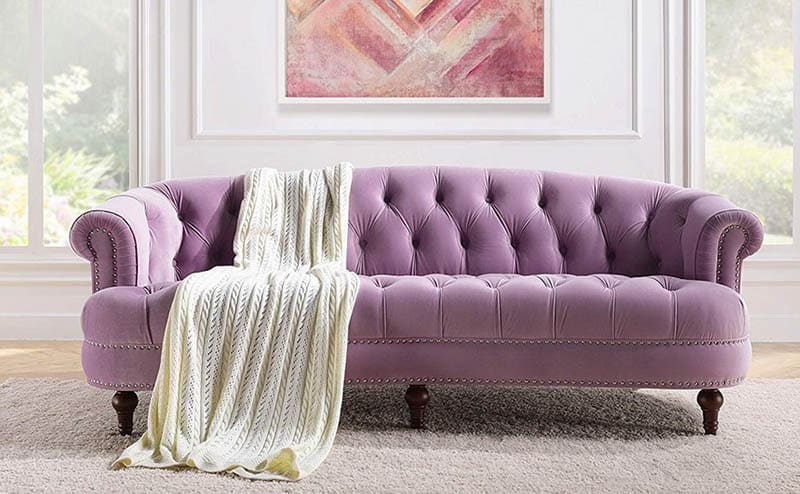
Just like other fabrics, velvet is also sometimes combined with other fibers like polyester to make it more durable. This type of fabric is known as poly-blend velvet and can withstand a lot of wear and tear over the years.
Velvet is available in a wide variety of couch colors. When used as a sofa cover, velvet can add elegance, sophistication and a luxurious flair to a space. It is highly suitable for use in areas with low traffic, such as formal living rooms, home offices, and bedrooms.
What makes it a good option for a sofa: Velvet is highly versatile and blends well with different interior decor styles, but the best advantage that it can offer is its exceptional softness. Fabrics with a pile are very comfortable to the touch. Although it appears to be delicate, this type of fabric is actually durable, but only to an extent. It is also a conductive material which makes it very useful for homes located in colder regions.
The drawbacks of velvet: Some options of velvet fabric are highly flammable. Velvet is difficult to clean and absorbs dust very quickly because of its pile. Any damage on its surface changes not only its appearance but also ruins its texture. As mentioned earlier, it is not fitted for use in high traffic areas since it can wear out quickly with use.
Chenille – Chenille is the known as the “cousin of velvet” because it also has a pile or nap. Just like velvet, chenille has a very soft texture and is fuzzy to the touch. In French, Chenille means “caterpillar” — as the fabric yarn resembles the insect’s fur.

Typically chenille fabric is made from synthetic fibers, specifically olefin and rayon. In some cases, it is also combined with polyester. This composition makes it heavy duty, very durable and easy to clean.
What makes it a good option for a sofa: Chenille has exceptional softness which makes it a very comfortable fabric for a sofa. It’s intricate texture makes it well suited for almost every area of the home, including the nursery.
In addition to its lovely texture, chenille also has a very unique visual aesthetic. The way the pile contrasts with the background fabric creates an interesting effect which adds dimension to its design. It’s also very versatile and available in a wide range of colors and patterns which can fit any interior design style.
Microfiber – One of the most popular sofa fabrics nowadays is Microfiber. Microfiber is a type of ultra fine polyester that has a distinct soft and velvety feel. It has a texture that is comparable to suede. The reason is that the fibers that make it up are very thin — about a fifth of a strand of human hair and even smaller than the diameter of a strand of silk.
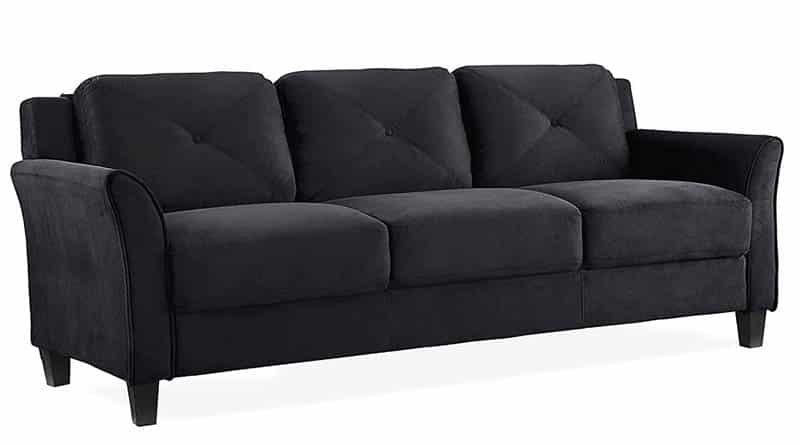
What makes it a good option for a sofa: Although soft, microfiber is extremely durable. It is very easy to clean — using only a damp cloth for wiping. Since its fibers are closely knit, any type of lint or pet hair is easy to brush off on its surface. The close threads also make it less vulnerable for pet scratches. Microfiber is also stain resistant but can still be treated for added protection.
Another reason for its growing appeal to decorators and homeowners alike is its versatility. Microfiber works for any type of sofa and can suit any interior design style. In addition to these amazing advantages, microfiber is reasonably priced and budget friendly. It is widely available in fabric stores in a variety of colors.
Leather vs Fabric Sofa
Leather versus fabric sofa? Which one is really better? — This is probably one of the most common questions that we encounter in choosing the best upholstery material for a sofa. And with all the additional options available in the market, shopping for the right sofa can indeed be a daunting task. It is also quite hard to compare the two since the category of “fabric” is broader than “leather” as there are different types of fabric produced for sofa upholstery.
To help you figure out the best answer to this question, we have broken down some of the highlights of each type of material. The answer actually lies on a number of different factors and what qualities you value the most. Comparing these factors like comfort, durability, maintenance and features, along with your personal preference, will help you decide which of the two options is most suitable for your home. Here is a detailed comparison of leather and fabric sofas:
Cost – Quality plays a significant role when it comes to the price and cost of sofa upholstery materials. The more premium the quality, the more expensive it is. But in general, leather will always cost more than a fabric sofa. In fact, a high quality premium fabric sofa costs just as much as a regular genuine leather sofa.
Although leather sofas can be more expensive, in the long run they are more cost-efficient. They are much easier to maintain, so consequently they also save time, effort and money.
Comfort – The comfort that you get from furniture will depend greatly on a number of factors , like the type of construction, anthropometrics, the frame and support system used, the sizes of cushion and lastly, the type of upholstery. But overall, fabric is more comfortable than leather.
The main drawback of leather upholstery is it absorbs heat faster than fabric. So if the weather is hot, it will feel quite warm sitting on it and sometimes, you may feel more sweaty and sticky after a while. Leather sofas are also firmer.
On the other hand, fabric sofas, depending on the type, are more soft to the touch and more comfy to use. You can lounge on it for hours and it works best in any type of weather.
Design, Appearance and Aesthetics – Fabric upholstery for sofas are available in thousands of variations, designs, colors and pattern. Just one type of fabric, say cotton blends for example, may be sold in different colors and prints. So it is safe to say that when it comes to design, fabric sofas will give you flexibility. You can always find a fabric in the market which will match your home’s color scheme and sofa’s style whether it may be traditional, transitional, contemporary or modern. Depending on the design, fabric sofas can render different vibes to a home.
A leather sofa, on the other hand, is also available in different colors, but compared to fabrics, it is much more limited. However, appearance wise, leather sofas have a very sleek and classic appearance which can add a distinct elegant flair to any room. This effect is hard to achieve when using fabric sofas.
Which one is better : It depends – When it comes to design and appearance, it will depend greatly on the look you are trying to achieve for your home. For example, if you are leaning towards creating a masculine vibe, then a leather sofa will be more fitting to use. While if you want to achieve a coastal theme for your home, you can opt for sofa fabrics which are woven and have refreshing colors.
Maintenance – There are different types of fabrics for sofas and each of this type have different qualities and lifespans when it comes to wear and tear. The higher the quality, the longer it will last and consequently, if the fabric is not premium quality then it has a lower lifespan. Some have special finishes and treatments which make maintenance fairly easy, like stain resistant fabrics or wrinkle resistant fabrics. But not all are exemplary when it comes to resisting wear and tear, as some fabrics tend to absorb stains more quickly that others.
On the other hand, leather sofas are more prone to scratches, marks and humidity. But despite this, they are much easier to maintain and often require simple wiping, dusting and vacuuming. Leather is very easy to clean as compared to a fabric sofa, because all you need to do is wipe it when liquids are spilled on it. However, it is not so pet friendly. Over time, weather can crack but this can be treated using leather polisher or softener.
Which one is better: When it comes to maintenance, leather sofas are better than fabric sofas. But if you have pets at home, it’s a draw between the two — because with leather sofas you have to deal with scratch marks, while with fabric sofas you have to deal with fur and pet hair. Otherwise, leather is relatively much easier to care for.
Durability – Just like all the other factors mentioned above, the durability of a leather and fabric sofa will depend on a number of things. But if we exclude construction, leather sofas are far more durable than fabric sofas. It is more lasting and its color does not fade easily.
In terms of aging, leather sofas tend to get more beautiful over time. They tend to develop a distinct sheen as time passes. Fabrics, on the other hand, tend to fade more quickly with wear and tear, frequent washing and aging.
Which one is better: When it comes to durability, leather sofas last longer than fabric sofas.
Safety – Safety is a significant consideration especially if you or a family member is dealing with allergies. Leather sofas are hypoallergenic and unlike fabric, they do not accumulate strong allergens like dirt, dust, mites or pet hair. On the other hand, fabrics – depending on its type may trigger allergies.
Most Durable Sofa Fabric
The sofa is one of the most used and abused furniture in the home. Over time, sofa upholstery tends to wear down due to weight, dirt, dust and friction. This is the primary reason why we need a sofa upholstery material that is going to hold up despite being constantly exposed to the said factors.
Most of us are aware that when it comes to durability, certain types of leather are very reliable and are proven to withstand heavy use. However, there is another very durable sofa upholstery material that is widely available in today’s market.
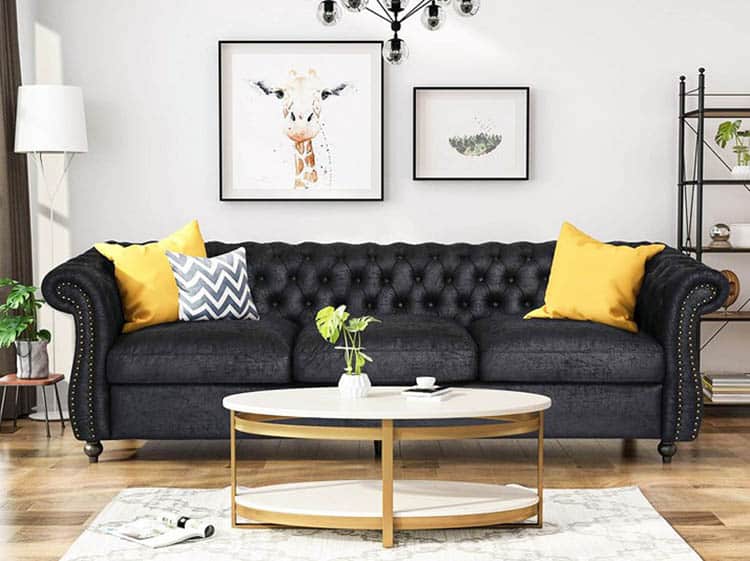
Synthetic microfiber is the most durable sofa fabric. The exceptional durability of microfiber can be attributed to its composition – ultra fine fibers tightly woven together. The tightness of the weave of synthetic microfiber eliminates any gaps where dirt and dust can penetrate. It is also designed to hold up against liquids, while also having the ability to withstand constant use, friction and weight.
But aside from its proven reliability as a sofa fabric, microfiber does not sacrifice texture, softness and overall comfort. Compared to the also durable leather, microfiber is more cool to the touch.
Best Sofa Fabric for Dogs and Cats
If you have pets at home, your best bet for sofa fabrics are those that have a tight weave. As mentioned earlier, tightly woven fabrics closes any gaps which become prone to accumulating pet hair. Also, the tighter the weave of your fabric, the less likely it is to get caught on your pet’s claws. Aside from the type of weave, it is also advisable to pick fabrics which have a dark color since they do not show dirt more easily. But alternatively, you can opt for a color that matches the hair of your pet so any loose hair won’t become too noticeable.
Undoubtedly, the best sofa fabric for dogs and cats is leather. Its remarkable durability assures that it won’t snag claws, and although it can get scratched, small wear and tears can actually add to its aesthetic value.
Leather is also easy to clean in case your pets cause a bit of mishap on your furniture – with just a clean damp cloth, you can wipe through a leather sofa and remove any dirt caused by your pet. Pet hair does not easily stick to leather couches too, which means they can also be easily vacuumed. A little static will cause any loose fur to come together and it can be easily picked up from the sofa’s surface.
If you do not like leather, there are other viable alternatives that you can explore for your sofa fabric. Synthetic microfiber, denim and canvas are all fabrics with tight weaves that are suitable for dog and cat owners. Microfiber does not easily scratch and any accumulated hair on its surface can be easily removed even by just using your hands.
Denim also works well because it can be easily spot cleaned with water, mild soda or a baking soda solution. Just like microfiber, denim can be easily vacuumed to remove any stray pet hair. Canvas, on the other hand, is a fabric intended for outdoor furniture so you can be sure that it can withstand any form of abuse from your pets. In addition, outdoor fabrics like canvas are typically treated for stain and odor resistance which means they can repel moisture and even bacteria.
What are the worst sofa fabrics for household with pets: If you have pets at home and are trying to choose the right type of sofa fabric, make sure to avoid materials that have a loose weave. Some examples of sofa upholstery materials that you need to avoid are silk, suede, velvet.
Best Fabric for Sofa Slipcovers
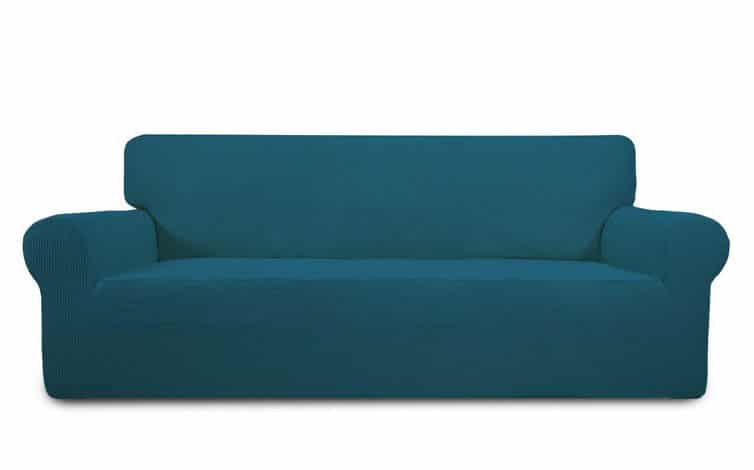
Slipcovers help prolong the lifespan of your sofa. They make a great investment not only because of the added protection that they give to your furniture, but also for the aesthetics that they offer. You’d be surprised as to how a new slipcover can instantly change and dramatically alter the look of an old and drab sofa.
When it comes to fabrics for slipcovers, the best ones to use are those which are machine washable. After all, that’s one of the main purposes of a slip cover – you put it on your couch to protect it from wear, tear, dust and dirt, then you take it off to wash it and make it clean again for use. They must be easy to maintain and must have medium weight so that they will lay nicely on your sofa.
Top fabrics for slipcovers
Cotton – Cotton is one of the most used fabric for slipcovers because not only is it machine washable but it is also lightweight. Cotton slipcovers are breathable, soft to the touch and very durable too. They stretch easily and fit nicely on a sofa. This natural fabric can also hold up to daily wear and tear, however, it has the tendency to wrinkle easily.
Maintenance wise, cotton slipcovers are easy to wash. And sometimes, even if it is still a little bit damp, it can be put back onto the sofa as it dries nicely and takes the right shape of the furniture nicely. When choosing cotton slipcovers, it is more advisable to go with a darker color since the lighter ones can be too thin.
Polyester Cotton Blend – The best thing with polyester cotton blend slipcovers is it combines the positive qualities of polyester and cotton fabrics. Polyester is a strong fiber that keeps it shape despite being used and it resists wrinkling, while cotton is a durable natural fiber that can withstand wear and tear, while also being breathable.
Polyester Cotton Blend slipcovers are easy to clean and do not shrink once washed. Compared to pure cotton, cotton polyester blends do not wrinkle easily.
Twill – Twill fabrics are also typically made up of 100 percent polyester cotton, but they can also be may of different fibers. They have a distinct diagonal type of weave which makes even lightweight fabrics stronger and more durable. Twill makes great sofa slipcovers because it resists staining, soiling and water damage. It is also highly suitable for households with pets as it can hold up to scratches. Twill is also machine washable and easy to maintain.
Suede – Suede makes great slipcovers because of its napped finish which gives it a soft, velvety texture. It resists staining and water damage and can withstand lots of wear and tear from daily use. Suede also lays down beautiful on a sofa and can also contribute a distinct elegant and luxurious feel to a furniture piece.
Stretch – Stretch fabrics work best for hard to fit sofas. It is made up of a blend of spandex and polyester which gives it flexibility elasticity and allows it to take the shape of a sofa nicely, In addition, stretch slipcovers also offer resistance to wrinkling. It is also easy to care for and maintain.


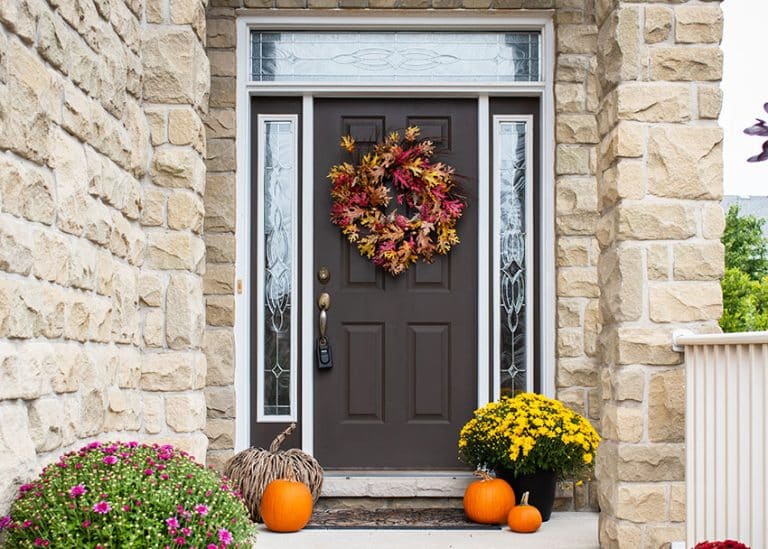

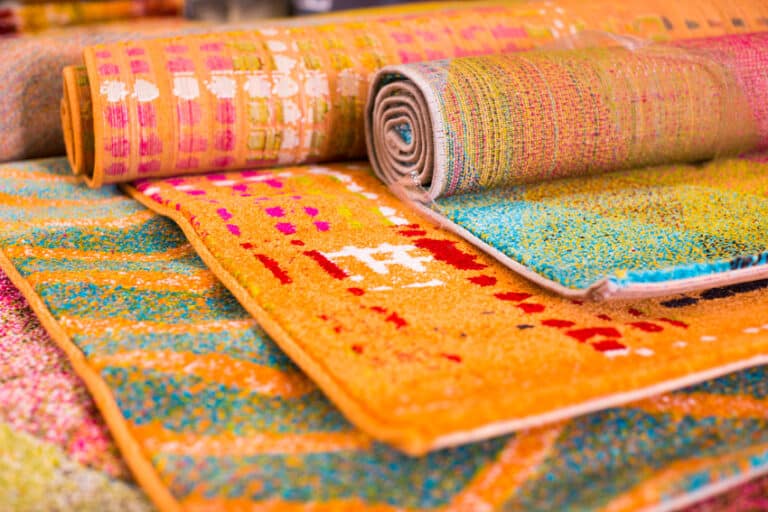
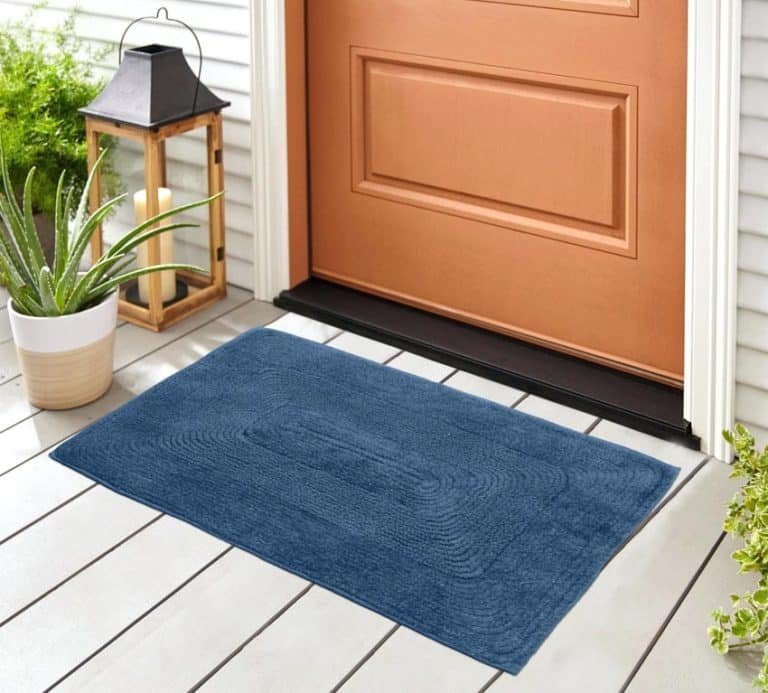
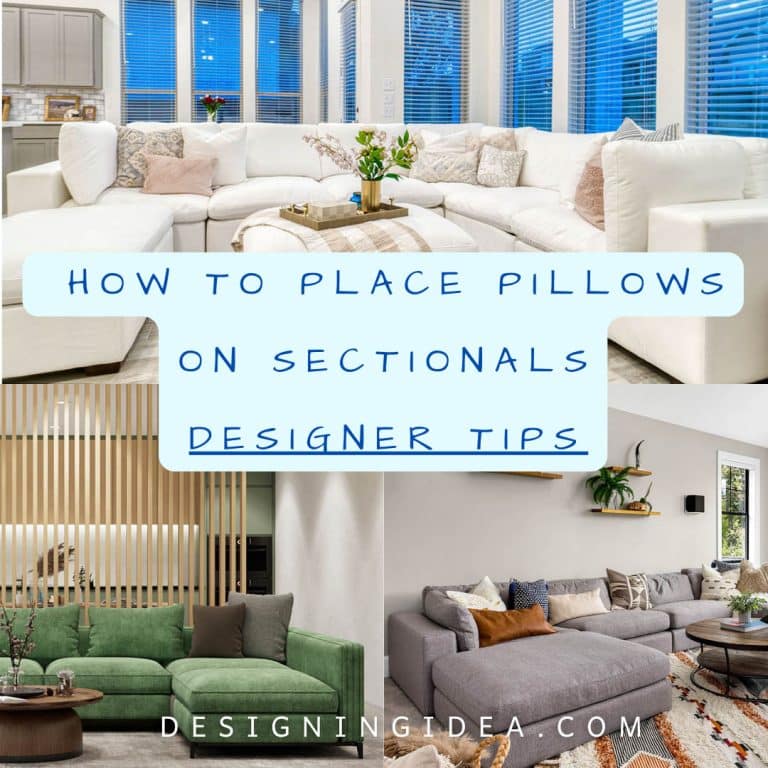
Very comprehensive guide for sofa fabrics